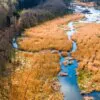Issue 20/2024, News
The mysterious depths of Loch Ness – the power of nature and a lasting legend
Deep within the Scottish Highlands lies Loch Ness, a place renowned not only for its rugged beauty but also for the legends of a mysterious creature that inhabits its dark depths. Nessie, as it is affectionately called by mystery enthusiasts, is the subject of heated debates, scientific research, and endless tales. Do these stories and legends contain even a grain of truth? Let’s dive into the world of Loch Ness and uncover what lies behind one of Scotland’s most intriguing locations.
Loch Ness – impressive and mysterious
Loch Ness is one of the largest lakes in Scotland, stretching 36 km in length across the picturesque Scottish Highlands. Its surface area is about 56.4 km², making it the second-largest lake in the country. However, what sets Loch Ness apart from other bodies of water is its remarkable depth, reaching up to 240 m in places. This allows the lake to hold more water than all the lakes in England and Wales combined.
One of the most distinctive features of Loch Ness is its mysterious, dark color. The water is nearly opaque due to a high concentration of peat particles. This characteristic makes Loch Ness even more intriguing—the water appears almost black, as if hiding undiscovered secrets. This impression is further enhanced by the fog that often rises above the lake’s surface, giving the area an aura of mystery and wildness.
The entire surrounding of Loch Ness emanates raw beauty and a unique atmosphere, attracting both nature lovers and seekers of extraordinary stories. Hills and small towns frame the lake, creating a landscape that is both picturesque and unsettling. For centuries, adventurers and scientists have sought to unravel the mystery of the creature that supposedly inhabits its depths.
Nessie – the legend of the Loch Ness monster
The legend of a monster inhabiting Loch Ness dates back to the 7th century. The first mentions appeared in the accounts of Saint Columba, an Irish monk and missionary who, according to legend, encountered the mysterious creature in 565 AD. According to the tale, when one of his companions attempted to swim across the lake, the monster emerged from the water and began to approach him. Saint Columba made the sign of the cross, and the creature allegedly vanished into the depths. This event, recorded as a miracle, marked the beginning of the tales about Nessie.
However, the real “frenzy” over Nessie erupted only in the 20th century. In 1933, a couple of tourists reportedly saw a mysterious creature on the road near the lake. Soon after, media outlets began publishing more eyewitness accounts, and researchers and adventurers flocked to Loch Ness. In 1934, surgeon Robert Wilson published the famous photograph, which purportedly captured Nessie’s head and neck rising from the water. The image quickly gained fame as evidence of the Loch Ness monster, although it was later revealed to be a hoax.

Despite this, belief in Nessie’s existence persisted. Loch Ness became the site of numerous scientific studies conducted with the latest technologies aimed at exploring the lake. In the 1960s, the first expeditions using sonar were organized to detect potential movements of large objects underwater. With technological advancements, infrared cameras, drones, and other sophisticated equipment were employed. Although the results of these studies did not conclusively prove Nessie’s existence, many claim that the evidence gathered suggests the presence of a large, unidentified creature in the lake.
In recent decades, Nessie has become a pop culture icon. It appears in books, films, and even as a tourist mascot for Scotland. The town of Drumnadrochit, located by the lake, has created a dedicated tourist center for the Loch Ness monster, attracting crowds of visitors from around the world. Nessie is also a subject of research for cryptozoologists who are trying to find evidence of unknown species.
Loch Ness today
Today, Loch Ness is one of the most recognizable lakes in the world, attracting adventure seekers and mystery enthusiasts. Every year, hundreds of thousands of tourists flock to the lake, eager to see this famous location with their own eyes. Tourism in the area is thriving—offering boat trips on the lake, hiking trails, and exhibition centers dedicated to Nessie. While science has yet to provide evidence of the monster’s existence, its legend endures and draws crowds, adding magic to the rugged beauty of Scotland’s landscapes.
main photo: Ramon Vloon









